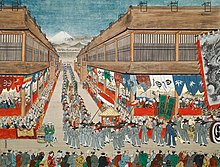
| Joseon Tongsinsa | |||||||
|---|---|---|---|---|---|---|---|
| Japanese name | |||||||
| Kanji | 朝鮮通信使 | ||||||
| |||||||
| Korean name | |||||||
| Hangul | 조선통신사 | ||||||
| Hanja | 朝鮮通信使 | ||||||
| |||||||
The Joseon Tongsinsa (Korean: 조선통신사) were goodwill missions sent intermittently, at the request of the resident Japanese authority, by Joseon dynasty Korea to Japan. The Korean noun identifies a specific type of diplomatic delegation and its chief envoys. From the Joseon diplomatic perspective, the formal description of a mission as a tongsinsa signified that relations were largely "normalized," as opposed to missions that were not called tongsinsa.[1]
Diplomatic envoys were sent to the Muromachi shogunate and to Toyotomi Hideyoshi between 1392 and 1590. Similar missions were dispatched to the Tokugawa shogunate in Japan between 1607 and 1811.[2] After the 1811 mission, another mission was prepared, but it was delayed four times and ultimately cancelled due to domestic turmoil in Japan that resulted in the establishment of the Meiji Restoration in Japan, after which Japanese relations with Korea took a markedly different tone.
- ^ Lewis, James Bryant. (2003). Frontier contact between chosŏn Korea and Tokugawa Japan, pp. 21–24.
- ^ Sin, Hyŏng-sik. (2004). A Brief history of Korea, p. 90.